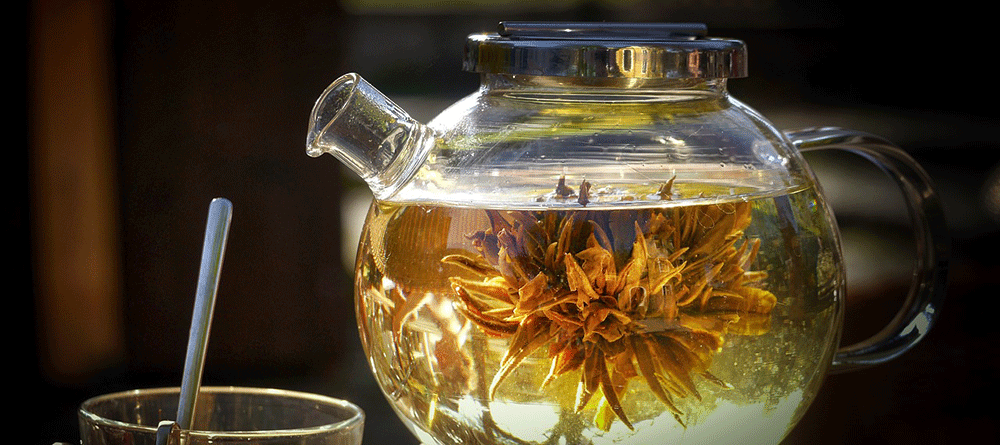Table of Contents
Introduction
In the enchanting world of tea, where traditions intertwine with innovation, few spectacles rival the captivating beauty of blooming tea. Defined by its artful fusion of hand-tied tea balls and vibrant floral displays, blooming tea is a sensory experience that transcends the ordinary. These intricately crafted tea bundles unfurl in hot water, revealing a mesmerizing dance of colors and shapes. Beyond its visual allure, blooming tea has become a symbol of sophistication and a cherished ritual in tea culture.
Blooming tea, also known as flowering tea or artisan tea, is a unique form of artisanal tea where hand-tied bundles of tea leaves and edible flowers blossom when steeped in hot water. The result is not just a beverage but a visual masterpiece, showcasing the artistry of tea craftsmanship.
At the heart of blooming tea are carefully selected tea leaves and dried edible flowers, skillfully bound together into compact balls. These tea balls are not merely a vessel for flavor infusion; they are a canvas waiting to unfurl in a delicate dance, revealing a hidden world within each bloom.
In recent years, blooming tea has captured the imaginations of tea enthusiasts worldwide. Its rise in popularity can be attributed to more than just its aesthetic appeal; blooming tea embodies a blend of tradition and contemporary elegance, making it a centerpiece in both traditional tea ceremonies and modern tea-drinking rituals.
Join us on a journey into the enchanting realm of blooming tea, where every cup tells a story, and each blossom is a work of art waiting to be savored.
Origins and History of Blooming Tea
In the heart of Chinese tea culture, blooming tea, or flowering tea, unfolds as a masterpiece of sensory delight and aesthetic expression. This captivating infusion transcends the conventional act of brewing, turning it into a mesmerizing visual spectacle. The essence of blooming tea lies in the meticulous handcrafting of bundles comprised of dried tea leaves and edible flowers. When immersed in hot water, these bundles gracefully unfurl, creating a stunning display that engages not only the taste buds but also the eyes.
Ancient Roots (Song Dynasty: 960–1279 AD)
The inception of blooming tea can be traced back to the Song Dynasty in ancient China. During this period, tea culture flourished, and artisans began experimenting with innovative ways of presenting tea. It is believed that the art of hand-tying tea leaves and edible flowers to create blooming tea bundles started during this era.
Cultural Flourishing (Ming Dynasty: 1368–1644 AD)
The Ming Dynasty witnessed the refinement and popularization of blooming tea. This unique form of tea preparation became intricately linked with Chinese tea ceremonies, where the visual appeal of the brewing process took center stage alongside the flavor. The act of unfurling tea leaves and flowers became an art form, captivating tea enthusiasts and connoisseurs.
Timeless Elegance (Qing Dynasty: 1644–1912 AD)
The Qing Dynasty further elevated blooming tea, solidifying its place in Chinese tea culture. The meticulous craftsmanship involved in creating these visual delights reached new heights. The delicate dance of flowers and leaves unfurling in hot water became a symbol of elegance and sophistication.
Revival in the Modern Era (20th Century Onward)
While blooming tea has deep roots in ancient traditions, it experienced a notable resurgence in the 20th century and beyond. In contemporary times, artisans and tea enthusiasts around the world rediscovered this ancient art, breathing new life into blooming tea. The craft evolved with modern sensibilities, allowing for experimentation with different tea varieties, flower combinations, and even aromatic herbs.
Global Fascination (21st Century)
In the 21st century, blooming tea transcended cultural boundaries, captivating tea lovers globally. Its mesmerizing visual appeal, coupled with the nuanced flavors, led to its widespread popularity. Blooming tea became more than a traditional beverage; it became a global symbol of tea artistry, connecting people to the rich heritage of Chinese tea culture.
As we indulge in blooming tea today, we sip from a cup that holds within it the echoes of centuries past. The artistry and cultural significance of blooming tea continue to thrive, offering a sensory journey that spans ancient dynasties to the contemporary tea renaissance.
The Art of Blooming Tea
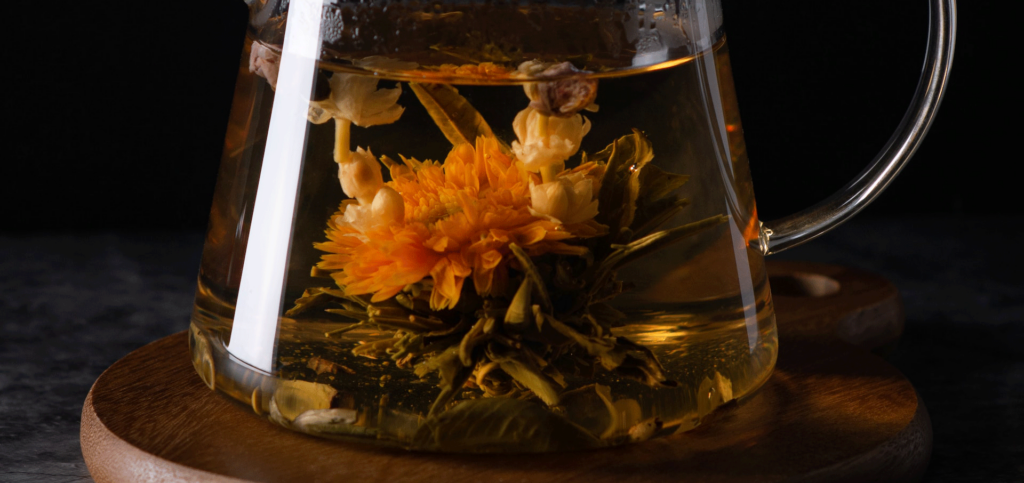
Blooming tea is not just a beverage; it’s a visual and sensory masterpiece that involves meticulous craftsmanship and a touch of artistry.
Crafting the Hand-Tied Tea Balls
The creation of hand-tied tea balls is a meticulous art that requires skill and precision. Expert artisans, often with years of experience, delicately bring together tea leaves and edible flowers to form these tightly bound orbs. Here’s a closer look at the craftsmanship involved:
- Selection of Tea Leaves:
- Artisans carefully choose high-quality tea leaves, often of a whole-leaf grade, ensuring that the tea ball unfurls gracefully during steeping.
- The choice of tea variety plays a crucial role in the flavor profile, ranging from delicate white teas to robust oolongs.
- Addition of Edible Flowers:
- The beauty of blooming tea lies in the inclusion of colorful and edible flowers. Varieties like jasmine, lily, hibiscus, and osmanthus are popular choices.
- The combination of tea leaves and flowers is not only for aesthetics but also contributes to the overall flavor and aroma of the brewed tea.
- Hand-Tying Technique:
- Artisans skillfully bind the tea leaves and flowers together using a traditional hand-tying technique. This step requires precision to ensure that the tea ball retains its shape and remains intact until brewed.
- Formation of Compact Bulbs:
- The bound tea leaves and flowers are shaped into compact bulbs or rosettes. The goal is to create a visually appealing and tightly packed structure that will slowly open up during the brewing process.
- Drying Process:
- Once the tea balls are intricately tied, they undergo a careful drying process. This step is crucial to set the shape and preserve the hand-tied integrity of the tea ball.
- Artistic Expression:
- Some artisans incorporate artistic elements into the hand-tying process, creating variations in shapes and patterns. This adds an extra layer of uniqueness to each blooming tea creation.
Crafting hand-tied tea balls is an art form that combines expertise, creativity, and a deep understanding of tea. The result is not only a delightful tea-drinking experience but also a visual spectacle that showcases the craftsmanship behind each blooming tea creation.
Intricate Floral Designs and Compositions
Each blooming tea ball is a miniaturized garden waiting to bloom in your teapot. The arrangement of tea leaves and vibrant flowers within the bulb is carefully designed to unfurl gracefully when steeped in hot water. The result is a captivating dance of colors and shapes, resembling a blooming flower right in your teacup.
Unique Teaware for Blooming Tea
To fully appreciate the artistry of blooming tea, specialized teaware adds another layer to the experience. Glass teapots or teacups allow you to witness the gradual unfurling of the tea ball, enhancing the visual spectacle. The transparency of the glass amplifies the beauty of the blooming process, turning your tea-drinking routine into a captivating display.
Blooming tea is a harmonious blend of nature and craftsmanship, transforming a simple act of brewing into an artful performance. The meticulous tying of tea leaves, the thoughtful composition of floral elements, and the use of specialized teaware collectively contribute to the visual and sensory feast that is blooming tea.
Exploring Blooming Tea Gardens
Famous Regions for Cultivating Blooming Tea
Embark on a journey through the lush landscapes of tea gardens where the delicate art of blooming tea comes to life. China stands as the cradle of blooming tea, with provinces like Fujian and Yunnan renowned for their picturesque plantations. These regions boast a rich history of crafting exquisite hand-tied tea balls, each infused with the unique terroir of its origin.
The hills of Taiwan, especially in Nantou and Alishan, contribute to the diversity of blooming tea. Here, the combination of high altitudes, misty climates, and fertile soils imparts a distinct character to the tea blossoms. These gardens not only produce visually stunning blooming teas but also contribute to the nuanced flavors that tea enthusiasts cherish.
Terroir’s Influence on Flavor and Appearance
Just as with any fine tea, the concept of terroir plays a pivotal role in shaping the identity of blooming tea. The interplay between soil composition, altitude, and climate determines the flavor profile and appearance of each blossom. From the delicate sweetness of jasmine blossoms in China to the vibrant hues of Taiwanese oolongs, terroir leaves its indelible mark on every petal.
The unique conditions of each region contribute to the complexity of blooming tea. Whether it’s the mountainous regions of China or the sun-kissed fields of Taiwan, the terroir adds layers to the sensory experience, making each cup a voyage through the landscapes where these tea blossoms unfurl.
Sustainable Practices in Blooming Tea Farming
As tea culture embraces sustainability, blooming tea gardens are no exception. Forward-thinking tea farmers are adopting eco-friendly practices to preserve the natural beauty of their plantations. Sustainable farming methods, such as organic cultivation and minimal pesticide use, not only contribute to environmental conservation but also enhance the purity of the blossoms.
Furthermore, initiatives focusing on fair labor practices and community well-being are gaining prominence in blooming tea gardens. These efforts ensure that the artistry of blooming tea extends beyond the cup, fostering a harmonious relationship between nature, tea artisans, and tea enthusiasts.
Exploring blooming tea gardens is more than a physical journey; it’s an exploration of the very essence of tea culture. It’s an invitation to witness the marriage of nature’s bounty with human craftsmanship, resulting in the captivating symphony that is blooming tea.
Types of Blooming Tea
Varieties of Flowering Tea Balls
Jasmine Blossom Tea
Jasmine Blossom Tea is a classic among blooming teas, renowned for its delicate and aromatic jasmine flowers. The hand-tied tea ball elegantly unfurls in hot water, releasing a fragrant bouquet that complements the smooth, subtly sweet flavor of green tea leaves. This variety offers a soothing and visually captivating tea-drinking experience.
Lily Fairy Tea
Lily Fairy Tea is a whimsical creation featuring vibrant lily flowers. As the tea ball unfurls, the lily blooms gracefully, creating a visually stunning display. The tea itself often combines green or white tea leaves with the subtle sweetness of the lily, resulting in a refreshing and floral-infused cup.
Osmanthus Burst Tea
Osmanthus Burst Tea introduces the delightful aroma of osmanthus flowers to the blooming tea experience. The tea ball reveals a burst of golden osmanthus flowers, imparting a sweet and fruity fragrance. Combined with the mellow notes of oolong or green tea, this variety offers a harmonious balance of flavors.
Flavor Profiles and Aromas
Blooming teas, in general, boast a mild and nuanced flavor profile. The choice of tea leaves, coupled with the infusion of edible flowers, contributes to a delightful combination of floral, sweet, and sometimes fruity notes. The aromas released during the blooming process add an extra layer of sensory pleasure, making blooming tea a multisensory experience.
Health Benefits of Blooming Tea
Beyond its aesthetic and flavor appeal, blooming tea offers potential health benefits. Like traditional tea, blooming tea contains antioxidants that may contribute to overall well-being. Additionally, the incorporation of edible flowers introduces unique compounds that could have additional health-promoting properties.
While the health benefits may vary depending on the tea and flowers used, blooming tea is generally a low-calorie and hydrating beverage. As with any tea, moderation is key to enjoying its potential positive effects.
In the world of blooming tea, each variety is a work of art that not only pleases the palate but also engages the senses in a visual spectacle. Whether you savor the gentle notes of jasmine, the elegance of lily, or the sweetness of osmanthus, blooming tea invites you on a journey of taste and beauty.
Brewing Blooming Tea
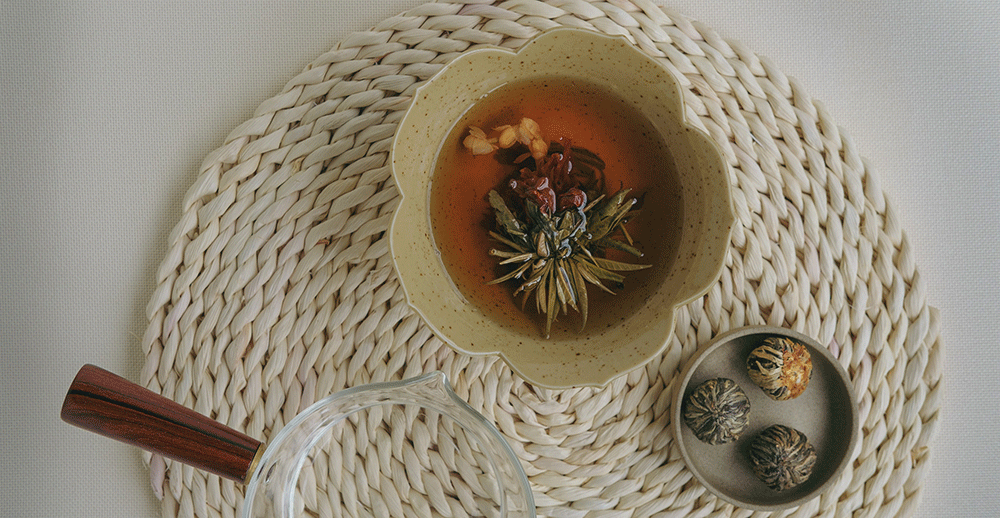
Proper Water Temperature and Brewing Time
Achieving the perfect infusion for blooming tea requires attention to water temperature and brewing time. Begin by bringing fresh, clean water to a gentle boil. For blooming teas, particularly those featuring green or white tea leaves, allow the water to cool slightly to around 176–185°F (80–85°C). This lower temperature helps preserve the delicate flavors of the tea and allows for a gradual unfurling of the blossoms.
Place the blooming tea ball in a clear glass teapot or teacup to fully appreciate the visual display. Pour the slightly cooled water over the tea ball, ensuring it is fully submerged. Allow the tea to steep for 3–5 minutes. This relatively short brewing time is sufficient for the leaves to unfurl and release their flavors without becoming bitter.
Tips for Enhancing the Blooming Experience
- Choose Clear Teaware: Opt for transparent teapots or teacups to fully appreciate the unfolding beauty of blooming tea. The visual aspect is as important as the taste.
- Experiment with Flavors: Blooming teas often feature a base of green or white tea leaves, offering a mild and slightly sweet foundation. Experiment by trying different blooming teas with varying floral additions for unique flavor profiles.
- Multiple Steeps: Don’t discard the blooming tea ball after a single steep. Many blooming teas can be steeped multiple times, each time offering a slightly different taste as the leaves continue to release flavors.
- Enhance with Sweeteners: While blooming teas are delightful on their own, you can customize your experience by adding natural sweeteners like honey or agave syrup. This can complement the floral notes and add a touch of sweetness.
Brewing blooming tea is not just a routine; it’s a ritual that engages all your senses. From the visual spectacle to the delicate flavors, every aspect of blooming tea brewing contributes to a unique and immersive tea-drinking experience.
Presentation and Serving
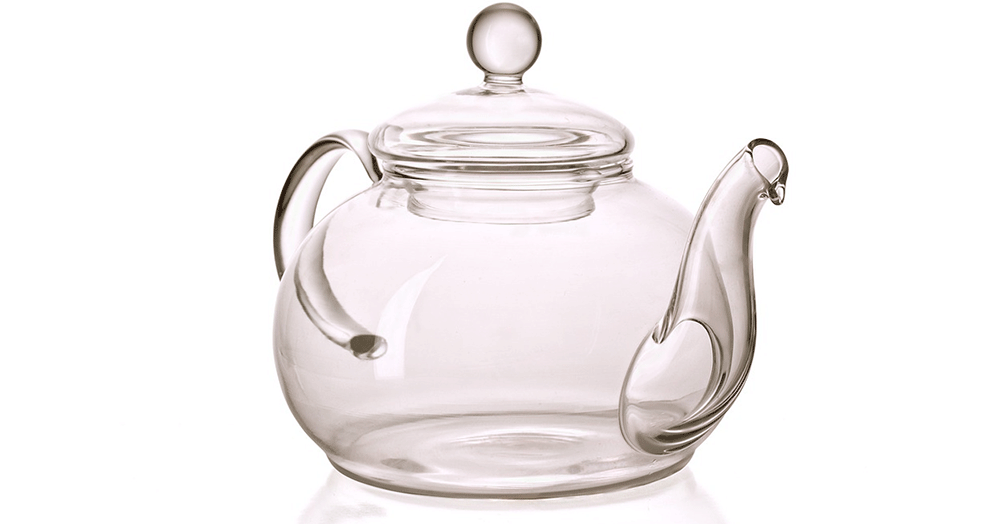
Choosing the Right Glass Teapot
The presentation of blooming tea is an integral part of the experience, and selecting the right teaware enhances the visual appeal. Opt for a glass teapot that allows you to showcase the blooming process. The transparency of the glass teapot enables you and your guests to witness the unfurling of the tea leaves and blossoms, turning the act of brewing into a captivating display.
Unveiling the Bloom in Front of Guests
Part of the charm of blooming tea is its theatrical quality. When serving blooming tea to guests, consider unveiling the bloom right at the table. As the tea ball unfurls, it releases vibrant colors and aromas, creating an enchanting atmosphere. This live presentation adds a sense of anticipation and wonder to the tea-drinking ritual.
Garnishes and Enhancements
Elevate the presentation and flavor profile of blooming tea by considering garnishes and enhancements. While blooming tea is a sensory delight on its own, you can add a touch of creativity to the experience:
- Edible Flowers: Complement the floral notes of blooming tea with edible flowers like pansies or violets. These delicate blooms not only enhance the visual appeal but also add subtle floral undertones to the tea.
- Citrus Zest: For a burst of freshness, consider adding a strip of citrus zest, such as orange or lemon, to the tea. The citrusy aroma can enhance the overall fragrance of the blooming tea.
- Herbal Infusions: Experiment with herbal infusions to add complexity to the flavor profile. A sprig of fresh mint or a few leaves of basil can introduce herbal notes that complement the blooming tea’s natural floral characteristics.
- Sweet Accompaniments: Serve blooming tea with sweet treats like light pastries or fruit slices to balance the delicate flavors. This creates a well-rounded tea experience that appeals to both the palate and the eyes.
Remember that blooming tea is not just a beverage; it’s a performance. The careful selection of teaware, the dramatic unveiling of the bloom, and thoughtful enhancements contribute to a memorable and visually stunning tea presentation for you and your guests.
Blooming Tea Rituals
Steeped in tradition and symbolism, blooming tea transcends the boundaries of a simple beverage, evolving into an artful and meaningful experience. As we delve into the rituals surrounding blooming tea, we uncover a world where each sip is not just a taste but a journey. From the intricacies of traditional ceremonies that showcase the unfolding beauty of tea leaves to the rich symbolism embedded in each bloom, blooming tea rituals offer a cultural tapestry that spans various tea-drinking societies. This chapter invites you to explore the nuanced ceremonies, discover the symbolism behind the delicate blooms, and understand the cultural significance that transforms a simple act of brewing into a profound and shared moment.
Traditional Ceremonies and Practices
In the rich tapestry of tea-drinking traditions, blooming tea holds a special place, and its consumption is often accompanied by captivating rituals that elevate the experience. The Chinese Gongfu Cha, renowned for its precision and aesthetics, extends its influence to blooming tea ceremonies. Here, the emphasis is on mastering the art of pouring and presenting tea, heightening the visual and aromatic aspects of the blooming process.
In traditional Chinese ceremonies, a clear glass teapot becomes a stage for the unfolding drama of a blooming tea ball. The carefully choreographed movements of the tea master involve pouring hot water over the tea ball, allowing it to gracefully unfurl and release its delicate petals. This method is not merely a means of brewing; it’s a performance, an art form where each step is deliberate and meaningful.
Japanese tea ceremonies, with their Zen philosophy, bring a serene and meditative atmosphere to blooming tea rituals. Here, the emphasis is on mindfulness and appreciating the transient beauty of the blooming process. The act of preparing and presenting blooming tea becomes a reflection of the harmony between nature, the tea drinker, and the moment.
In both cultures, the shared aspect of blooming tea ceremonies is the celebration of beauty, both in the visual spectacle of the blooming process and the aromatic symphony it creates. These ceremonies, steeped in history and cultural significance, turn a simple act of brewing tea into an artful expression of tradition and mindfulness.
The Symbolism Behind Blooming Tea
Blooming tea is rich in symbolism, representing more than just a beverage. The tightly bound tea ball symbolizes potential and hidden beauty, akin to a tightly closed bud. As it unfurls in hot water, it signifies the blossoming of that potential into a full, vibrant bloom. This symbolism is often associated with themes of rejuvenation, transformation, and the unfolding of life’s beauty.
Cultural Significance in Tea-Drinking Societies
In tea-drinking societies where rituals hold cultural significance, blooming tea has become a symbol of hospitality and shared experiences. The act of brewing and enjoying blooming tea together fosters a sense of connection and appreciation for the fleeting yet exquisite moments in life. Blooming tea ceremonies are not just about the tea itself but also about the artistry and mindfulness that accompany the entire process.
Blooming tea rituals often find their roots in traditional tea ceremonies like the Chinese Gongfu Cha or the Japanese Way of Tea (Chanoyu). These ceremonies emphasize the aesthetics, etiquette, and shared moments that make tea-drinking a cultural and spiritual practice.
Whether partaking in a formal ceremony or creating a personal ritual, blooming tea invites individuals to slow down, appreciate the unfolding beauty, and savor the moment. The cultural significance of blooming tea extends beyond its delightful flavors, turning each cup into a celebration of nature, art, and the joy of shared experiences.
Blooming Tea in Modern Culture
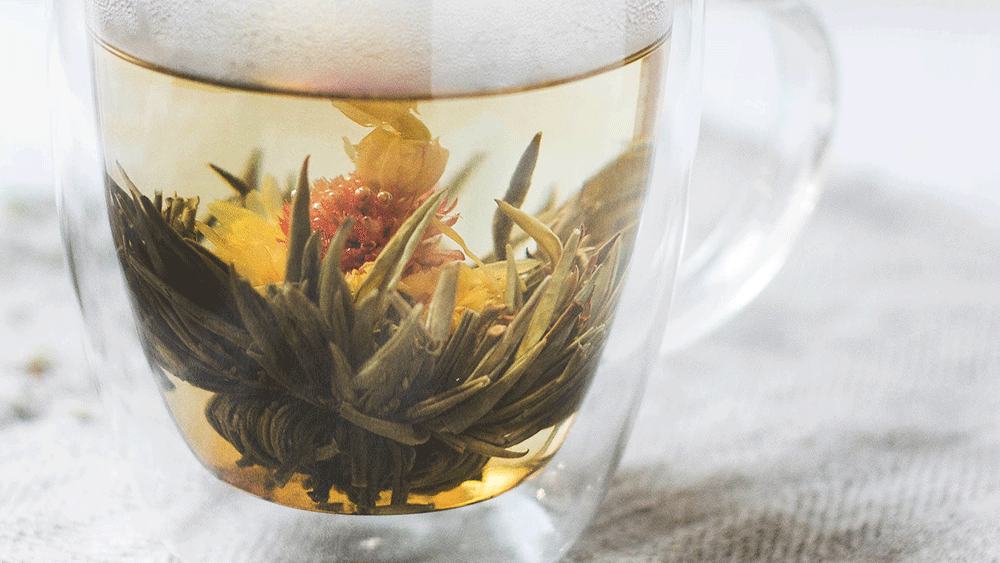
In the contemporary tea landscape, blooming tea has seamlessly merged tradition with innovation, finding its place in modern culture through various avenues.
Incorporation in Tea Blends and Mixology
Modern tea artisans and mixologists have embraced the captivating allure of blooming tea, integrating it into innovative tea blends and mixology. The delicate visual display and nuanced flavors of blooming tea balls add a touch of sophistication to tea-based creations. Mixologists craft unique tea-infused cocktails, where blooming tea serves as both a visual spectacle and a flavor enhancer.
Social Media Trends and Aesthetics
The visual appeal of blooming tea aligns seamlessly with the aesthetics-driven culture of social media. The mesmerizing unfurling of petals, the vibrant hues, and the overall sensory experience make blooming tea a favorite subject for Instagrammers, YouTubers, and tea enthusiasts across various platforms. The hashtag #BloomingTea often accompanies posts that showcase the beauty of this tea artistry.
Global Appreciation and Adoption
As global tea appreciation grows, blooming tea has found admirers far beyond its traditional roots. Tea enthusiasts worldwide are drawn to the unique experience offered by blooming tea, appreciating not only its aesthetic qualities but also the delicate infusion of flavors. Its global adoption reflects a universal appreciation for the artful nature of tea drinking.
In the modern era, blooming tea has transcended cultural boundaries and become a symbol of the marriage between tradition and contemporary tea culture. Whether enjoyed for its visual spectacle, nuanced flavors, or creative applications, blooming tea continues to captivate tea lovers around the world.
Conclusion
As we conclude our exploration of blooming tea, it’s evident that this delicate art form transcends the boundaries of a traditional tea-drinking experience. Blooming tea’s allure lies not only in its aesthetic charm but also in the delicate dance of flavors that unfold with each unfurling petal.
From the meticulous craftsmanship of hand-tied tea balls to the mesmerizing blooming process, blooming tea invites us into a world where every blossom tells a story. The artistry involved in creating these floral displays reflects a deep-rooted tradition that has evolved and adapted to captivate modern tea enthusiasts.
Our journey through the origins, types, brewing methods, and cultural significance of blooming tea is an invitation to explore and experience the beauty within every blossom. It encourages tea enthusiasts to embrace the sensory delights of blooming tea, from its subtle aromas to the visual spectacle of petals unfolding in hot water.
In every cup of blooming tea, there’s a moment of serenity—a pause in our busy lives to appreciate the beauty within every blossom. It’s a reminder that tea is not just a beverage; it’s an art form, a cultural symbol, and a source of joy. Blooming tea encapsulates the essence of this sentiment, inviting us to savor not just the flavors but the beauty inherent in the ritual of tea-drinking.
So, let each cup be a celebration, each blossom a work of art, and each sip a journey into the rich tapestry of blooming tea. May your tea moments continue to be filled with beauty, tranquility, and the subtle elegance that blooming tea brings to the world of tea culture.

